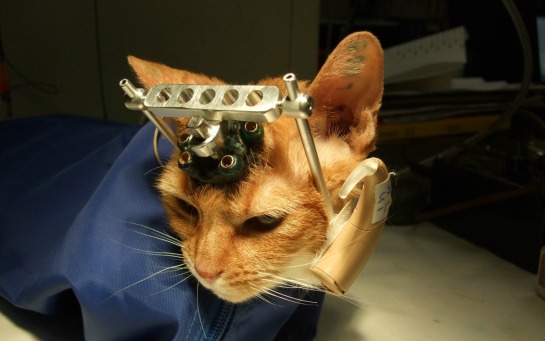
The 64th Annual National Meeting of the American Association for Laboratory Animal Science (AALAS) convened in Baltimore from October 27-31 bringing together scientists and policy makers in academia and industry from across the globe, and if the theme of the conference could be described in two words, they would be “best practices.” Participants discussed the latest developments in animal research to advance both human and animal health.
The potential of what can be accomplished with animals in the laboratory is at its greatest. Scientists today can breed animals to contain exactly the genes of interest, often those that are hypothesized to be associated with diseases or conditions. For instance, a scientist can make a mouse with Parkinson’s Disease, Alzheimer’s Disease, or even one prone to obesity. These animal models could help us find treatments or cures for these diseases in humans.
While creating genetically modified animals is expanding the horizon for discoveries in healthcare, there is a need for increased caution and improved technique. Dr. Melissa Larson, of the International Society for Transgenic Technologies, explained that the national average efficiency rate in breeding transgenic mice is about 10-20%. The remaining mice are born wild type, without the desired genotype. These extra mice, she explained, are “typically euthanized.”
Within AALAS, a growing movement calls for saving the lives of research animals and using them only when necessary. These best practices are the 3R’s: replace, reduce, and refine. Dr. Kathryn Chapman, Head of Innovation and Translation, at the National Center for the Replacement, Refinement, and Reduction in Animal Research (NC3Rs) explained each of these R’s with a question and natural answer:
1. Is information from animals always needed when we think it is? We should replace animal tests with alternative methods, such as computer simulations or in vitro models with human cells.
2. Are as many animals needed as we think? We should reduce the number of animals used by performing the experiment with care and precision the first time, without unnecessary duplications.
3. Now, while using the minimum number of animals and only when necessary, we ask: how can we improve the welfare of these animals? We should refine procedures to minimize potential animal pain.
Scientists are embracing the 3Rs for many reasons. Firstly, these best practices represent a pathway to better science. Chapman further explained, “animals may be poor predictors of humans. We are not necessarily getting translation from animals to humans.” Other factors include company incentives and government pledges to move away from animal use; better selection of drug chemicals before testing on animals; changing cultural perceptions around animal research; increased ability to experiment with human cells rather than live animals; and financial savings.
Dr. Joanne Zurlo, Director of Science Strategy at the Johns Hopkins Center for Alternatives to Animal Testing (CAAT), attended the conference and said of AALAS, “they read our mission statement and say ‘we agree with all of this.’” When asked if CAAT faces resistance, Zurlo answered, “There is always skepticism because they don’t know what side we’re on. We are on the side of science.” Zurlo elaborated, “If they [animals] are not kept under the best conditions, then they won’t be reliable research subjects.” It is becoming clear that advocates for alternatives to animal testing, and scientists who use animals, are on the same side.
William Russell, a zoologist, and Rex Burke, a microbiologist, first developed the 3R’s in 1959. In the 1980’s, many countries and laboratories began instituting policies to promote and enforce the 3Rs, and at the 2013 AALAS National Meeting, these guidelines stood out as the way of the future. While promoting animal welfare as a means for better results may sound like a modern notion, this idea has been made obligatory in Islam since revelation.
Animals, in Islam, represent signs of Allah’s omnipotence and beauty. Like us, animals have their own laws and communities, and Allah explains in the Qur’an:
“There is not an animal on earth, nor a bird that flies on its wings, but they are communities like you.” 6:38
The fact that Allah created animals like humans, in communities, shows that we should apply our same moral standards to them. While we have dominion over animals, “He (God) it is Who made you vicegerents on earth” (Holy Qur'an, 35:39), our role as vicegerents comes with great responsibility. Allah commands us to serve with reason, and warns against injustice:
“And be not like those who say, ‘We have heard,‘ while they do not hearken. Verily, the vilest of all creatures, in the sight of Allah, are those deaf and dumb ones who do not use their rationality” (Holy Qur’an, 8:21, 22).
In both the Qur’an and Sunnah, Muslims are commanded to manage animals with compassion. The Prophet Muhammad peace and blessings be upon him, enumerated on countless occasions, the importance treating animals well. One such hadith says:
“The Prophet passed by a camel who was so emaciated that his back had shrunk to his belly, and said: ‘fear God in these beasts - ride them in good health and free them from work while they are still in good health’.” ABU DAWUD
These guidelines from the Qur’an and Sunnah existed before the 3Rs, and are incumbent upon ever Muslim. Prophet Muhammad peace be upon him declared:
“There is no man who kills (even) a sparrow or anything smaller, without its deserving it, but God will question him about it.” Narrated by Ibn’Umar and by Abdallah bin ‘Amar bin al-Nas.
While we embrace the 3Rs of today, we ought to also return to what we know from the Qur’an and Sunnah which provides the divine best practices for animal welfare and better results, in this life and forever.









Comments powered by CComment